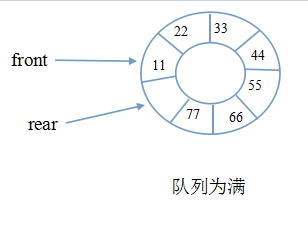java 实现循环队列
1 . 数组 elem 存储队列元素。
front 和 rear 分别表示对头和对尾。
usedSize表示存储的有效位的个数。
allSize表示数组的长度。
数组仅存储 allSize - 1 个元素,还有一个空间被浪费。
循环队列不能用rear = rear + 1指向下一个元素,会发生越界,而要用this.rear = (this.rear+1) % this.allSize。
class QueueLink{
int elem[];
int front;//对头
int rear;//对尾
int usedSize;//有效数字个数。
int allSize = 10;
public QueueLink(){
this(10);
}
public QueueLink(int size){
this.elem = new int[size];
this.front = 0;
this.rear = 0;
}
2 . 循环队列的基本操作。
a . 判断队列是否为满。
public boolean isFull(){
return (this.rear+1) % this.allSize == this.front;
}
b . 入队。
public void push(int val){
//判断是否为满。
if(isFull()){
return;
}
this.elem[this.rear] = val;
this.rear = (this.rear+1) % this.allSize;
this.usedSize++;
}
c . 判断队列是否为空。
public boolean isEmpty(){
return this.front == this.rear;
}
d . 出队。
public void pop(){
if(isEmpty()){
return;
}
this.elem[this.front] = -1;
this.front = (this.front+1)%this.allSize;
this.usedSize--;
}
e . 得到队头元素。
public int getTop(){
if(isEmpty()){
return -1;
}
return this.elem[this.front];
}
f . 输出队列元素。
public void show(){
for(int i = this.front; i < this.rear; i = (i+1) % this.allSize){
System.out.print(this.elem[i]+" ");
}
System.out.println();
}

